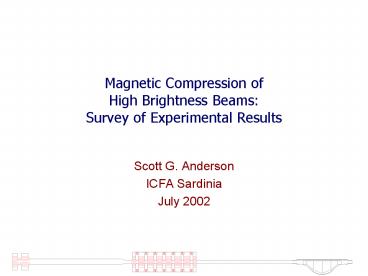Magnetic Compression of High Brightness Beams: Survey of Experimental Results - PowerPoint PPT Presentation
Title:
Magnetic Compression of High Brightness Beams: Survey of Experimental Results
Description:
Title: Magnetic Compression of High Brightness Beams: Survey of Experimental Results Author: Scott Anderson Last modified by: Scott Anderson Created Date – PowerPoint PPT presentation
Number of Views:98
Avg rating:3.0/5.0
Title: Magnetic Compression of High Brightness Beams: Survey of Experimental Results
1
Magnetic Compression of High Brightness
BeamsSurvey of Experimental Results
- Scott G. Anderson
- ICFA Sardinia
- July 2002
2
Magnetic Compression
- Motivation increase brightness, need sub-ps
bunches - Problems 6D phase space deterioration caused by
collective effects - Acceleration fields Coherent Synchrotron
Radiation (CSR) - Velocity fields Space-charge
- Experiments
- CTF, TTF, SDL, APS, UCLA,
- Features of the data
- Phase space dilution emittance growth, momentum
spectrum - Phase space filamentation both longitudinal and
transverse - Comparisons with theory/simulation
- Simulations reproduce rms quantities, but not
intricate phase space structures seen in expt.
3
Operating Principle of Magnetic Compression
- Acceleration ahead of crest of rf wave chicane
dipoles - acts as lens drift.
accelerating wave
4
CTF II Emittance Measurements
- Large bend plane emittance growth observed as a
function of compression - Only CSR and/or space-charge were reasonable
sources of De - PARMELA predicts 10 of measured De
- CSR-TRACK predicts 60 of measured De
from H. H. Braun, et al., Phys. Rev. Lett. 84,
658 (2000).
5
CTF II Emittance and Momentum Distribution
Measurements
- from H. H. Braun, et al., Phys. Rev. ST Accel.
- Beams 3, 124402 (2000).
6
CTF II Emittance versus Horizontal Size
7
TTF
8
TTF
9
SDL
- Strong micro-bunching with compression source
not agreed upon.
10
APS?
11
UCLA Experiment
- Lower energy (lt 12 MeV) space-charge may play
significant role in compression - This allows/requires emittance measurement using
slits - Transverse phase space is directly measured
12
Interferometer Data
Normalized Signal
Delay Arm Position
13
Emittance Versus PWT Phase
Sharp increase is a consistent feature in data
14
Bifurcation of Transverse Phase Space
sz 4 ps
sz 0.6 ps
15
Varying Phase or Field
- Emittance growth and phase space structure is a
function of compression.
Emittance mm mrad
Pulse Length psec
16
Emittance Growth Vs Beam Size
Emittance Growth mm mrad
sx mm
17
Simulation
- Different codes model different processes
(acceleration fields versus velocity fields.) - Codes employed
- TREDI Solves Lienard-Wiechert potentials.
- PARMELA Provides input distributions for
TREDI. Point-to-point space charge for
comparison. - ELEGANT CSR only calculation.
- Simulations indicate that for this experiment,
acceleration fields do not contribute much
emittance growth, the space charge fields are the
dominant effect.
18
Simulation
Emittance mm mrad
PWT Phase deg.
- Simulation is difficult. Number of
macro-particles is low because of time-intensive
space-charge calculations. - Sharp emittance increase when bifurcation begins
is missing in simulations.
19
Heuristic Model
- To analyze the effect of space-charge in the
compressor, we model the beam as a series of
longitudinal slices. - Since the beam energy spread is heavily
correlated to slice position, we assume that
there is no energy spread (no dispersion) within
a single slice. - Space-charge forces push a slice based on the
fields at its centroid due to the other slices. - Use standard envelope equations to evolve the
sizes of single slices.
20
Configuration Space gymnastics in the Model
(no space-charge)
Beam folds over in configuration space.
Configuration Space
Long. Phase Space
21
Space-charge in the model
ellipsoid edge
- In simple model integrate ? space-charge force in
last magnet to get Dx between slices - Model predicts size dependence
- In simulation use 3D ellipsoidal fields
Cartoon of config. space evolution.
22
Simple calculation with the model
Emittance mm mrad
x mrad
s/Rq
s0
- Kick applied between two slices in the last
magnet.
23
Slice Model Simulation
Configuration space
Trace space bifurcation
Input size dependence
24
Bifurcation in PARMELA
z phase space
Energy distribution
Config. space
25
Summary of UCLA Experiment
- Features of the data
- Trace space bifurcation
- Emittance growth inversely proportional to beam
size - Simulation shows that space-charge is the
dominant effect - Slice model simulation, and PARMELA/TREDI
simulations show same features as data, but not
as pronounced. Possible pre-existing structure
in phase space and/or CSR combines with
space-charge effects to accentuate behavior seen
in data. - Blue statements seem applicable to other
experimental data as well!

